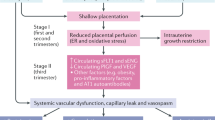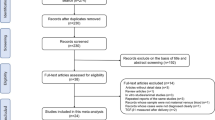Abstract
Changes in circulating angiogenic factors seem to play a key role in the pathogenesis of preeclampsia and it seems as if these changes are of greater importance in the pathogenesis of early-onset than of late-onset disease. Endostatin is a potent, broad spectrum antagonist of angiogenesis whose role in preeclampsia is poorly investigated. The aim of this study was to estimate whether circulating endostatin levels are altered in preeclampsia, and whether women with early-onset (before 32 weeks of gestation; n = 16) and late-onset (after 35 weeks of gestation; n = 19) preeclampsia differ in this regard. Women with early-onset, but not of late-onset preeclampsia had higher levels of endostatin than healthy pregnant women in corresponding lengths of gestation. The results of the study support the hypothesis that there is heterogeneity between early- and late-onset preeclampsia, with a stronger association between an altered angiogenic balance and early-onset than late-onset disease.
Similar content being viewed by others
References
Redman CW, Sargent IL. Placental stress and pre-eclampsia: a revised view. Placenta. 2009;(30 suppl A):S38–S42.
Roberts JM, Hubel CA. Is oxidative stress the link in the two-stage model of pre-eclampsia? Lancet. 1999;354(9181):788–789.
Redman CW, Sargent IL. Latest advances in understanding preeclampsia. Science. 2005;308(5728):1592–1594.
Maynard S, Epstein FH, Karumanchi SA. Preeclampsia and angiogenic imbalance. Annu Rev Med. 2008;59:61–78.
Egbor M, Ansari T, Morris N, Green CJ, Sibbons PD. Morphometric placental villous and vascular abnormalities in earlyand late-onset pre-eclampsia with and without fetal growth restriction. BJOG. 2006;113(5):580–589.
Aardema MW, Saro MC, Lander M, De Wolf BT, Oosterhof H, Aarnoudse JG. Second trimester Doppler ultrasound screening of the uterine arteries differentiates between subsequent normal and poor outcomes of hypertensive pregnancy: two different pathophysiological entities? Clin Sci (Lond). 2004;106(4):377–382.
Vatten LJ, Skjaerven R. Is pre-eclampsia more than one disease? BJOG. 2004;111(4):298–302.
Maynard SE, Min JY, Merchan J, et al. Excess placental soluble fms-like tyrosine kinase 1 (sFlt1) may contribute to endothelial dysfunction, hypertension, and proteinuria in preeclampsia. J Clin Invest. 2003;111(5):649–658.
Ahmad S, Ahmed A. Elevated placental soluble vascular endothelial growth factor receptor-1 inhibits angiogenesis in preeclampsia. Circ Res. 2004;95(9):884–891.
Wikstrom AK, Larsson A, Eriksson UJ, Nash P, Norden-Lindeberg S, Olovsson M. Placental growth factor and soluble FMS-like tyrosine kinase-1 in early-onset and late-onset preeclampsia. Obstet Gynecol. 2007;109(6):1368–1374.
Folkman J. Antiangiogenesis in cancer therapy—endostatin and its mechanisms of action. Exp Cell Res. 2006;312(5):594–607.
O’Reilly MS, Boehm T, Shing Y, et al. Endostatin: an endogenous inhibitor of angiogenesis and tumor growth. Cell. 1997;88(2):277–285.
Sottile J. Regulation of angiogenesis by extracellular matrix. Biochim Biophys Acta. 2004;1654(1):13–22.
Dhanabal M, Ramchandran R, Waterman MJ, et al. Endostatin induces endothelial cell apoptosis. J Biol Chem. 1999;274(17):11721–11726.
Kim YM, Hwang S, Pyun BJ, et al. Endostatin blocks vascular endothelial growth factor-mediated signaling via direct interaction with KDR/Flk-1. J Biol Chem. 2002;277(31): 27872–27879.
Wu P, Yonekura H, Li H, Nozaki I, Tomono Y, Naito I, et al. Hypoxia down-regulates endostatin production by human microvascular endothelial cells and pericytes. Biochem Biophys Res Commun. 2001;288(5):1149–1154.
Pollheimer J, Bauer S, Huber A, Husslein P, Aplin JD, Knofler M. Expression pattern of collagen XVIII and its cleavage product, the angiogenesis inhibitor endostatin, at the fetal-maternal interface. Placenta. 2004;25(10):770–779.
Mahmound RA, Abdel-Raouf M. Serum endostatin and vascular endothelial growth factor levels in patients with pre-eclampsia. East Mediterr Health J. 2006;12(1–2):178–87.
Hirtenlehner K, Pollheimer J, Lichtenberger C, et al. Elevated serum concentrations of the angiogenesis inhibitor endostatin in preeclamptic women. J Soc Gynecol Investig. 2003;10(7): 412–417.
Wathen KA, Ylikorkala O, Andersson S, Alfthan H, Stenman UH, Vuorela P. Maternal serum endostatin at gestational weeks 16–20 is elevated in subsequent pre-eclampsia but not in intrauterine growth retardation. Acta Obstet Gynecol Scand. 2009;88(5):593–598.
Wikland KA, Luo ZC, Niklasson A, Karlberg J. Swedish population-based longitudinal reference values from birth to 18 years of age for height, weight and head circumference. Acta Paediatr. 2002;91(7):739–754.
Redman CW, Sargent IL. Placental debris, oxidative stress and pre-eclampsia. Placenta. 2000;21(7):597–602.
Ergun S, Kilic N, Wurmbach JH, et al. Endostatin inhibits angiogenesis by stabilization of newly formed endothelial tubes. Angiogenesis. 2001;4(3):193–206.
Gupta AK, Gebhardt S, Hillermann R, Holzgreve W, Hahn S. Analysis of plasma elastase levels in early and late onset preeclampsia. Arch Gynecol Obstet. 2006;273(4):239–242.
Wen W, Moses MA, Wiederschain D, Arbiser JL, Folkman J. The generation of endostatin is mediated by elastase. Cancer Res. 1999;59(24):6052–6056.
Ahmed A, Li XF, Dunk C, Whittle MJ, Rushton DI, Rollason T. Colocalisation of vascular endothelial growth factor and its Flt-1 receptor in human placenta. Growth Factors. 1995;12(3):235–243.
Esser S, Wolburg K, Wolburg H, Breier G, Kurzchalia T, Risau W. Vascular endothelial growth factor induces endothelial fenestrations in vitro. J Cell Biol. 1998;140(4): 947–959.
Shibuya M. Structure and function of VEGF/VEGF-receptor system involved in angiogenesis. Cell Struct Funct. 2001;26(1):25–35.
DiFederico E, Genbacev O, Fisher SJ. Preeclampsia is associated with widespread apoptosis of placental cytotrophoblasts within the uterine wall. Am J Pathol. 1999;155(1): 293–301.
Johansen M, Redman CW, Wilkins T, Sargent IL. Trophoblast deportation in human pregnancy—its relevance for pre-eclampsia. Placenta. 1999;20(7):531–539.
Smarason AK, Sargent IL, Starkey PM, Redman CW. The effect of placental syncytiotrophoblast microvillous membranes from normal and pre-eclamptic women on the growth of endothelial cells in vitro. Br J Obstet Gynaecol. 1993;100(10): 943–949.
Cockell AP, Learmont JG, Smarason AK, Redman CW, Sargent IL, Poston L. Human placental syncytiotrophoblast microvillous membranes impair maternal vascular endothelial function. Br J Obstet Gynaecol. 1997;104(2):235–240.
Goswami D, Tannetta DS, Magee LA, et al. Excess syncytiotrophoblast microparticle shedding is a feature of early-onset pre-eclampsia, but not normotensive intrauterine growth restriction. Placenta. 2006;27(1):56–61.
Author information
Authors and Affiliations
Corresponding author
Additional information
This work was carried out at the Department of Women’s and Children’s Health, Uppsala University, Sweden.
This study was financially supported by the General Maternity Hospital Foundation, the Gillberg Foundation, the Swedish Society of Medicine, and the Uppsala-Orebro Regional Research Council.
Rights and permissions
About this article
Cite this article
Wikström, AK., Larsson, A., Åkerud, H. et al. Increased Circulating Levels of the Antiangiogenic Factor Endostatin in Early-Onset But Not Late-Onset Preeclampsia. Reprod. Sci. 16, 995–1000 (2009). https://doi.org/10.1177/1933719109339348
Published:
Issue Date:
DOI: https://doi.org/10.1177/1933719109339348




